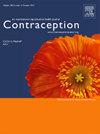美国高中生在使用避孕方法方面的种族和性别差异。
IF 2.3
2区 医学
Q1 OBSTETRICS & GYNECOLOGY
引用次数: 0
摘要
目的:探讨性活跃的高中生在最后一次性接触中使用预防怀孕方法的种族、民族和性别差异。研究设计:使用来自全国代表性青年风险行为调查(2015-2019)的三波横断面数据来分析只与异性伴侣发生性行为的性活跃学生。R及其调查包用于估计平均边际百分比、风险差异和置信区间。结果:结果显示,在避孕药具的使用上存在显著的性别差异。女性(52.4%)报告使用安全套的可能性明显低于男性(61.4%)。女性报告使用口服避孕药(23.2% vs 19.1%)或长效可逆避孕(11.8% vs 5.4%)的可能性明显高于男性。黑人(23.2%)、西班牙裔(21.0%)和亚裔(23.0%)女性使用口服避孕药或长效可逆避孕药的可能性明显低于白人(45.6%)女性。在不使用预防怀孕或可靠的预防怀孕方法方面存在显著的种族差异。约37%的亚洲女学生没有使用避孕套或任何可靠的避孕措施。结论:总体而言,美国女高中生避孕药具的使用率较低。除了避孕套的使用外,男高中生少报了避孕措施的使用情况。与白人学生相比,黑人、西班牙裔和亚洲女学生使用可靠避孕措施的可能性明显较低。对政策和实践的影响:需要努力缩小避孕药具使用方面的种族差距,并增加所有性活跃学生的避孕药具使用。本文章由计算机程序翻译,如有差异,请以英文原文为准。
Race-ethnicity and sex disparities in the use of pregnancy prevention methods among U.S. high school students
Objective
To examine race-ethnicity and sex differences in the reported use of pregnancy prevention methods at the last sexual encounter among sexually active high school students.
Study design
Three waves of cross-sectional data from the nationally representative Youth Risk Behavior Survey (2015–2019) were used to analyze sexually active students who exclusively had sex with opposite-sex partners. R, with its survey package, was used to estimate average marginal percentages, risk differences, and confidence intervals.
Results
Results showed significant sex differences in the use of contraceptives. Females (52.4%) were significantly less likely to report condom use than males (61.4%). Females were significantly more likely than males to report the use of oral contraceptive pills (23.2% vs 19.1%) or long-acting reversible contraception (11.8% vs 5.4%). Black (23.2%), Hispanic (21.0%), and Asian (23.0%) females were significantly less likely than White (45.6%) females to use oral contraceptive pills or long-acting reversible contraception. There were significant race-ethnicity differences in not using pregnancy prevention or a reliable pregnancy prevention method. About 37% of Asian female students did not use condoms or any reliable form of contraception.
Conclusions
Overall, the use of contraceptives among U.S. female high school students was low. Except for condom use, male high school students underreported the use of contraceptives. Black, Hispanic, and Asian female students are significantly less likely to use reliable contraception compared to White students.
Implications
Efforts are needed to close the race-ethnicity gap in contraceptive use and increase contraceptive use among all sexually active students.
求助全文
通过发布文献求助,成功后即可免费获取论文全文。
去求助
来源期刊

Contraception
医学-妇产科学
CiteScore
4.70
自引率
17.20%
发文量
211
审稿时长
69 days
期刊介绍:
Contraception has an open access mirror journal Contraception: X, sharing the same aims and scope, editorial team, submission system and rigorous peer review.
The journal Contraception wishes to advance reproductive health through the rapid publication of the best and most interesting new scholarship regarding contraception and related fields such as abortion. The journal welcomes manuscripts from investigators working in the laboratory, clinical and social sciences, as well as public health and health professions education.
 求助内容:
求助内容: 应助结果提醒方式:
应助结果提醒方式:


